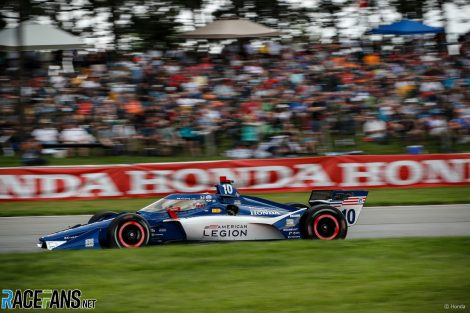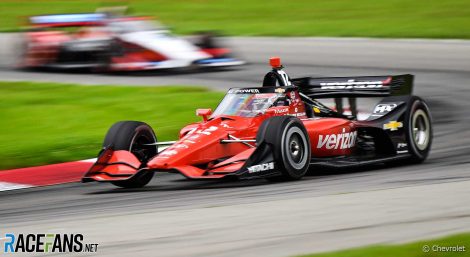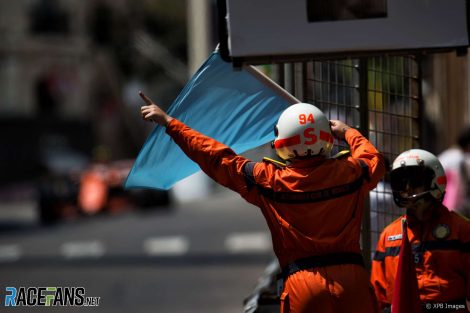Alex Palou, Will Power and Scott McLaughlin were just a handful of the drivers that weren’t too happy with IndyCar rookie Benjamin Pedersen after Sunday’s Indy 200 at Mid-Ohio.
Pedersen didn’t collide with anyone. Indeed, he never broke any rules. But his spirited driving as he tried to stay on the lead lap late did not go down well with IndyCar’s front-runners.Palou saw most of his eight-second lead to Colton Herta vanish while trying to get past AJ Foyt Racing’s Pedersen in the middle stages of the race.
After Palou finally cleared Pedersen, other drivers including Power and McLaughlin had to work arguably much harder than they should have to get past the car and driver who eventually finished off the lead lap, 26th and last of those who met the chequered flag.
“He’s not going to make any friends if he holds people up,” McLaughlin said after finishing fifth, then confronting Pedersen directly in the pit lane after the race. “He’s not even in our race.”
“I get he’s in a race of his own, but it’s give-and-take in this series – and if I’m a lap down and the number 55 [car of Pedersen] is behind me, who knows what I’m going to do.”
This has put a practice that is not unique to IndyCar, and is common across many major American motorsport series, back under scrutiny.
Advert | Become a RaceFans supporter and
Any slower car that is not on the lead lap is typically shown the blue flag and ordered to yield to the faster car behind them. The difference between IndyCar and series such as Formula 1 has to do with how cars on the tail end of the lead lap are dealt with.

This is not the case in IndyCar, where drivers are not ordered to yield position unless they are a lap down to the entire field. They are allowed to fight in an attempt to stay on the lead lap – or get back onto it – as long as they do not make themselves a nuisance to the lead car or those battling for position on the lead lap.
NASCAR has a similar policy in place for cars that are either on the tail end of the lead lap or just behind the leader who has lapped them. Drivers are warned that the leaders are approaching, but are not required to let the other drivers pass them right away. In fact, until 2003, there was an unspoken agreement that if the track wet to full-course caution, drivers could race all the way back to the start-finish line in an attempt to stay on the lead lap.
Typically this is all well and good in the unusual cases of a genuinely fast car that has comparable pace to the leaders, but fell off the lead lap due to some misfortune earlier in the race. But it’s typically not as welcomed when it’s a backmarker that doesn’t have the pace to be racing hard with the leader.
Pedersen is hardly the first such driver to incur the wrath of a frontrunner while fighting to stay on the lead lap – and he won’t be the last. Mid-Ohio is a circuit where overtaking is quite difficult for these high-powered single-seaters.
Advert | Become a RaceFans supporter and
In 2017, Will Power was not too pleased with the efforts of Dale Coyne Racing driver Esteban Gutierrez to stay on the lead lap. The veteran of three seasons of F1 nearly wrecked Power’s team mate Josef Newgarden after a Safety Car restart.
“It’s actually not Gutierrez’s fault,” Power said after the 2017 race. “The rules for IndyCar are kind of ridiculous, that the team would tell him to stay and push and he’s not even in the lead.”

“I think that the blue flag rule, it’s crazy,” said the reigning IndyCar champion. “You use push-to-pass up and have to race somebody that’s going to be a lap down like you’re racing for position. The series is so tight and competitive, and everyone is so good now, that I think we could have a blue flag rule.”
There is much less opportunity for drivers to get back onto the lead lap in IndyCar today, said Power. “It’s not like we have yellows constantly and you’re going to get your lap back. Maybe they do it in the second half of the race, but it’s ridiculous when a leader gives up 10 seconds.”
Palou, whose only impediment on the way to his fourth win in the last five IndyCar races was the encounter with Pedersen, generally agrees with Power on this topic. “I know the rules, but at the same time, it’s very frustrating when you are leading and you try to open the gap, and they don’t let you pass – but they are using the overtake, like 20, 30s a lap, to try to stay up front.
Advert | Become a RaceFans supporter and
“On top of that once you are side-by-side, they are so aggressive defending. Obviously it’s really frustrating when you are leading.
“You are using more fuel, you are using more tyres, and you’re not able to do the race you want just because of a backmarker car that wants to stay on the lead lap. The issue is that once you pass them, they let everybody pass because they already lost the lap, right?”
That was not what Power discovered in the case of Pedersen. “We should have a talk about it, I think,” Power he said, indicating drivers’ attempts to engage the series on the matter had fallen on deaf ears.
Palou also seemed resigned to the fact that the rules would not change. “It’s frustrating. I know it’s the rules. I would like it to change. It’s not going to change,” he said.
As an alternative, Power suggested “disabling the push-to-pass” for drivers who are about to be lapped, making it easier for the leaders to get by. He said that “would be a big step.”
IndyCar does have the right to disable the ‘overtake button’ for certain cars but only if they have gone a lap down to the entire field, not just the race leader.
Advert | Become a RaceFans supporter and
It’s hard to put a pin on why IndyCar, NASCAR, and other forms of American motorsport handle backmarkers in this manner. But one theory could be the way championship points and prize money are distributed to every car and driver who starts a race – instead of in F1 where only the top ten finishers receive points, and the prize money is paid out at the end of the season. Every position that can be gained or retained in an IndyCar (or NASCAR) race means more points and more money, which is harder to do if a driver is pinned a lap or more down and unable to fight for their track position.

Is there a better way of doing things? Two years ago, while talking about his encounter at Indy with the lapped car of Hinchcliffe, Power suggested an alternative that would be less of an irritant to the race leaders while also being fair to those drivers who would be fighting on-track to stay on the lead lap .
“Just bloody give them their lap back if it goes yellow,” said Power at the time with characteristic bluntness. “Give anyone who’s a lap down their lap back. Give them one simple fix.
“I don’t even think the guys that are trying to stay on the lead lap like it, because they don’t want to be a pain in the ass. They would like to get out of the way, and it’s such a simple fix.”
While F1 drivers have raised the popularity of borrowing some rules from IndyCar – such as preventing drivers who cause red flags in qualifying sessions from benefiting from them by deleting their lap times – the flow of ideas could work both ways.
Until there’s a change – if there’s a change at all – Pedersen won’t be the last backmarker to get under the skin of IndyCar’s top drivers because they exercised their right to fight for every position that they can.
Advert | Become a RaceFans supporter and
IndyCar
- McLaughlin denies Power pole position to lead Penske one-two in Barber
- Newgarden admits he “failed my team miserably” over disqualification
- Ghiotto gets 11th hour call-up for IndyCar debut at Barber
- McLaughlin and Power accept penalties over misuse of push-to-pass system
- Pourchaire sure he’ll get more chances to join F1 after strong IndyCar debut





Proesterchen (@proesterchen)
4th July 2023, 18:55
Yes, it is crazy to allow drivers who are miles behind in the race to fight.
Move over, let the other through, and aspire to be quicker next time, so you earn the right to fight them.
Gerrit
4th July 2023, 20:11
I like the Kyle Larson quote after the Chicago Nascar race when he was passed by SVG. He simply set back and started to learn how Shane drove and how he could improve his own driving on the damp street circuit.
Sometimes one has to be humble and be prepared to learn. Peterson would have been smarter to let the faster cars through and take lessons on how to drive faster. Learning driving lines and braking points he, as a rookie, simply cannot as yet fathom.
bernasaurus (@bernasaurus)
4th July 2023, 21:27
Giving lapped cars the lap back under yellow does create a few problems. Where they are in the field, presumably they’d be expected to drop to the back of the pack. But they’ve saved a lap of fuel and presumably some tyre life.
Power is right though when he says it’s not the lapped drivers fault. They might be slow, but they’re not daft. They know they’re impeding the race at the front, and I’m sure they fully appreciate how frustrating it must be for the leader. But they’ve got their own problems.
I’m a sense they are fighting the leader, just the leader isn’t / shouldn’t be fighting them.
Lyndamarks
4th July 2023, 21:32
These are what the blue flag rules traditionally always were.
They never became ‘get out the way now’ until F1 did it in 1995/96.
I personally prefer the old way of drivers having to fight through traffic as it’s another element of driver skill, Some are better at it than others and it creates another interesting dynamic which can create exciting and memorable moments (Mansell’s pass on Senna at Hungary in 1989 for instance).
Modern drivers have simply forgotten how to race without help and gimmicks.
anon
5th July 2023, 8:04
Lyndamarks, not necessarily – the interpretation of what a blue flag meant fluctuated over time and depending on which motorsport body you were referring to.
During the 1956 Argentine Grand Prix, for example, it seems that the drivers did interpret the blue flag as an explicit instruction to slow and let another driver through – there was a notable incident when Luigi Piotti was shown a blue flag and he braked quite sharply, causing Peter Collins to run into the back of him as he was trying to lap Piotti.
You can also look back to some of the rulebooks issued to competitors and marshals during the 1950s, and some of those did also indicate that a blue flag was a strict instruction, not advisory – I believe the BRDC’s one from that era stated that a blue flag indicated a driver should move off the racing line and allow a faster driver through.
JV
5th July 2023, 8:49
Cars are more reliant on aerodynamics nowadays. It doesn’t have much to do with driver skill, if the way the car works simply makes it impossible to pass. The comparison to older cars is like apples to oranges. There’s a whole lot of other issues that need to be solved first.
Mark Zastrow (@markzastrow)
4th July 2023, 21:53
I think the reason the US does it this way is less about prize money and more to do with the oval heritage. Learning to fight through backmarkers was always considered part of the craft of short oval racing. Go back to Nigel Mansell in 1993 and he raved about how much fun it was to race in traffic on ovals:
He is talking about backmarkers in that quote, because it was common back then for only a few cars to finish on the lead lap.
Also, on a one-mile oval, during a pit cycle or if someone goes off strategy, it’s very common for the effective leaders to go a lap or even two laps down — obviously, they’re not going to be shown a blue flag, which makes a blanket policy hard to implement.
There’s no reason IndyCar couldn’t institute a blue-flag rule for road courses only, but I personally like that is one of the things that makes Indy car racing unique.
skydiverian (@skydiverian)
6th July 2023, 7:03
It’s more to do with strategy combined with much shorter tracks. Long Beach is less than 2 miles in length, the new downtown Detroit track less than 1.65 miles, with qualifying lap times being around 67 and 62 seconds respectively. Of the 12 road & street courses on the schedule for this year, all are between 1.6 and 2.44 miles long, except Road America at over 4 miles long.
Compare those tracks to the current F1 calendar. If you ignore Monaco, every F1 track is longer than every Indycar road or street circuit bar Road America, with Zandvoort at 2.646 miles being the next shortest F1 track (though Mexico City, Sao Paulo and Austria are all less than 2.7 miles long).
Indycar’s problem is that the lap times of their tracks are too short and stops are significantly longer than in F1. With a pit stop taking 7-8 seconds stationary and around 30 for the full stop, it’s very easy to be in range of a blue flag if you pit from midfield and are around 30-35 seconds behind the leader. If the blue flag rules worked like they do in F1, undercutting isn’t possible as you could potentially be hit with a blue flag despite having a faster car. It’s not ideal (and clearly wasn’t the case with Pederson on Sunday) but I get why Indycar is happy with the current rules and has no desire to change them as you don’t want to limit options for a driver who’s in the middle of the pack – especially when you can come from well back to a decent finish with the right strategy as shown by Pato O’Ward at the weekend.
Biskit Boy (@sean-p-newmanlive-co-uk)
5th July 2023, 8:21
Trying to stay on the lead lap is understandable, but that’s more about the fact that so much ground can be gained without merit in FCY conditions.
Fighting cars below 1st position when you are lapped and slower than most of the field makes no sense. It was making Pedersen slower and making it harder to get a lap back, not easier.
Indycar should have blue flags where appropriate (maybe not most ovals), but the driver being lapped should just drive normally, as fast as they can and on the racing line. They should not drive defensive lines or use the overtake button to defend. I think this would be fair.
baasbas
5th July 2023, 8:37
Hate the game, not the player
chimaera2003 (@chimaera2003)
5th July 2023, 12:54
Not sure what the answer is here, but seeing leaders being involuntarily compelled/forced to use push-to-pass to overtake backmarkers is something that shouldn’t happen. I would rather that was all saved for fights for position.
More generally, I am not against having lapping cars actually having to work to overtake back markers as long as it is a skill that will separate drivers which to me is good. Having cars being forced to move out the way in awkward spaces and losing lots of time spoiling any battle they are in isn’t great in my view.
Something along the lines of not getting blue flags if you are still on the same lap as the passing car but not having any DRS/PtP to help defend will probably prevent excessive issues whilst offering enough of a challenge to lapping cars. This should maybe only apply if the ‘overtake delta’ is under a certain amount otherwise it will be cause more problems than it will solve (eg Monaco).
Don
5th July 2023, 15:38
I agree with WP. Change the rule.
Prashanth Ramadas
7th July 2023, 1:12
Very good tracks. The car looks cool too.